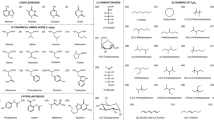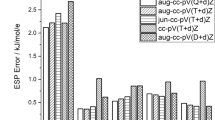Summary
The derivation of a new 3D QSAR field based on the electrotopological state (E-state) formalism is described. A complementary index and its associated field, the HE-state, describing the polarity of hydrogens is also defined. These new fields are constructed from a nonempirical index that incorporates electronegativity, the inductive influence of neighboring atoms, and the topological state into a single atomistic descriptor. The classic CoMFA steroid test data set was examined with models incorporating the E-state and HE-state fields alone and in combination with steric, electrostatic and hydropathic fields. The single best model was the E-state/HE-state combination with q2=0.803 (three components) and r2=0.979. Using the E-state and/or HE-state fields with other fields consistently produced models with improved statistics, where the E-state fields provided a significant, if not dominant, contribution.
Similar content being viewed by others
References
Kier, L.B. and Hall, L.H., Pharm. Res., 7 (1990) 801.
Hall, L.H. and Kier, L.B., J. Chem. Inf. Comput. Sci., 31 (1991) 76.
Kier, L.B. and Hall, L.H., Adv. Drug Res., 22 (1992) 1.
Joshi, N. and Kier, L.B., Med. Chem. Res., 1 (1993) 409.
Tsantili-Kakoulidou, A., Kier, L.B. and Joshi, N., J. Chim. Phys., 89 (1992) 1729.
Tsantili-Kakoulidou, A. and Kier, L.B., Pharm. Res., 9 (1992) 1321.
Hall, L.H. and Kier, L.B., Med. Chem. Res., 2 (1992) 497.
Hall, L.H., Mohney, B.K. and Kier, L.B., Quant. Struct.-Act. Relatsh., 12 (1993) 44.
CramerIII, R.D., Patterson, D.E. and Bunce, J.D., J. Am. Chem. Soc., 110 (1988) 5959.
Molconn-Z 3.0, Hall Associates Consulting, Quincy, MA, U.S.A.
Molconn-Z 3.0S, EduSoft, LC, Ashland, VA, U.S.A.
SYBYL 6.2, Tripos Inc., St. Louis, MO, U.S.A.
Kellogg, G.E., Semus, S.F. and Abraham, D.J., J. Comput.-Aided Mol. Design, 5 (1991) 545.
Nayak, V.R. and Kellogg, G.E., Med. Chem. Res., 3 (1994) 491.
Abraham, D.J. and Kellogg, G.E., In Kubinyi, H. (Ed.) 3D QSAR in Drug Design: Theory, Methods and Applications, ESCOM, Leiden, The Netherlands, 1993, pp. 506–522.
Kellogg, G.E., Joshi, G.S. and Abraham, D.J., Med. Chem. Res., 1 (1992) 444.
Hinze, J. and Jaffe, H.H., J. Am. Chem. Soc., 84 (1962) 540.
Kier, L.B. and Hall, L.H., J. Pharm. Sci., 70 (1981) 583.
Author information
Authors and Affiliations
Rights and permissions
About this article
Cite this article
Kellogg, G.E., Kier, L.B., Gaillard, P. et al. E-state fields: Applications to 3D QSAR. J Computer-Aided Mol Des 10, 513–520 (1996). https://doi.org/10.1007/BF00134175
Received:
Accepted:
Issue Date:
DOI: https://doi.org/10.1007/BF00134175




